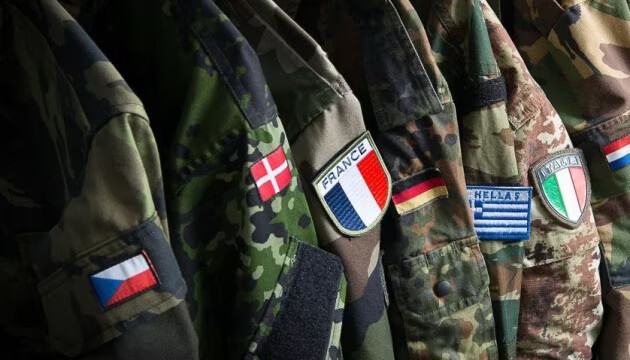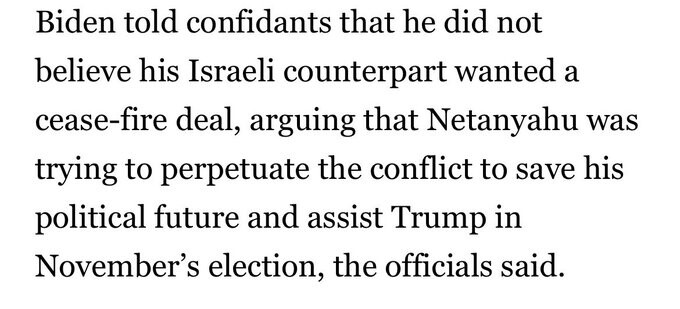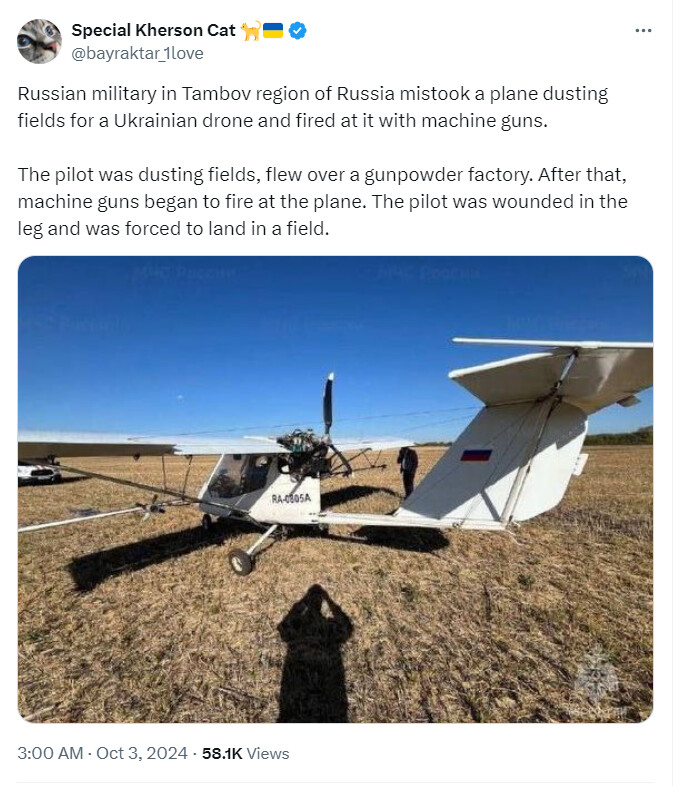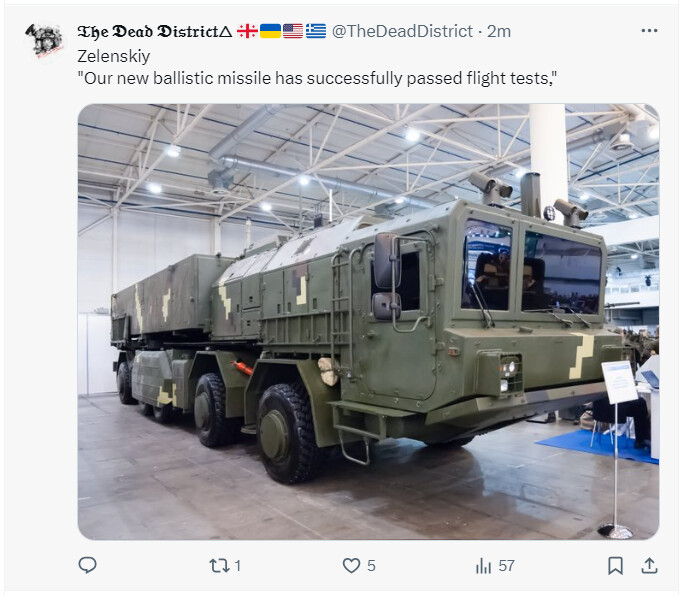The latest OCHCR report will go to the Human Rights Council, after which it could go forward to UNGA, depending on a decision by the Council.
Membership of the Council is comprised of UN States for an elected 3 year term, according to the number of seats based on regional distribution. Australia belongs to the Western Europe and Other group (WEOG) which holds 7 seats of a total 47 seats.
Within each group, there are negotiations to determine candidates for vacancies on a notional rotational basis.
Australia’s most recent membership expired in 2020.
Russia Deploys ‘Largest Non-Nuclear Bomb’ in Ukraine: Reports
Published Oct 02, 2024 at 12:12 PM EDTUpdated Oct 02, 2024 at 7:12 PM EDT
Newly released footage shows Russian forces striking a Ukrainian town, using what pro-Kremlin sources have claimed is one of the most potent non-nuclear weapons in the world.
On Tuesday morning, videos began circulating on Russian and Ukrainian media of a “vacuum bomb” being dropped on the town of Vovchansk in the country’s northeastern Kharkiv Oblast.
Ukrainian news agency InsiderUA posted the video to its Telegram channel, citing Russian military bloggers who said that the bomb was the ODAB-9000, a three-ton glide bomb sometimes referred to as “the father of all bombs.”
In the video, the bomb can be seen descending from the top right corner of the screen, exploding in the already derelict city and damaging the surrounding buildings.
A pro-Ukrainian Telegram channel shared the video but said that the munition was the ODAB-3000 thermobaric bomb and that the use of the more powerful explosive was a lie spread by “Rashists,” a Ukrainian term used to refer to members and backers of the Russian Armed Forces.
A thermobaric or “vacuum” bomb draws in oxygen to generate intense, high-temperature combustions. According to the International Review of the Red Cross, an international law-focused academic journal produced by the humanitarian organization, the use of thermobaric weapons in built-up, civilian areas could constitute a war crime.
Russian “milbloggers” have continued to share the footage and reiterate claims that the bomb was the ODAB-9000, which one called “the most powerful non-nuclear munition in the world.”
“A decision was made to use something awesome in Volchansk: The ODAB-9000 vacuum bomb. The first use during the entire war,” another prominent pro-Kremlin channel wrote alongside the video.
“I doubt that any of [them] survived,” it added, using a common ethnic slur for Ukrainians.
The Telegram channel for the operational and tactical unit (OTU) of Kharkiv responded to the claims.
“The information about the alleged use of the ODAB-9000 aerial bomb by the Russian occupation forces in Vovchansk is not true,” it said before referencing a statement given by Kharkiv OTU spokesperson Vitaliy Sarantsev.
“For the use of this munition, a suitable carrier is required, which theoretically could be, for example, a Tu-160 strategic bomber, but the movement of such aircraft was not recorded,” Sarantsev was quoted as saying. “A smaller weight and power munition was used, the explosion of which was used by propagandists to create a ‘spectacular’ picture.”
Sarantsev said that footage of the strike and claims that the ODAB-9000 caused the explosion was likely intended to demoralize Ukraine’s Armed Forces, as well as the local population.

Emergency workers stand amid the rubble after a Russian attack in Kharkiv, Ukraine, on September 24. Pro-Kremlin bloggers claimed that Russia used an ODAB-9000 thermobaric bomb on a town in the Oblast. ANDRII MARIENKO/AP PHOTO
Russia’s strike in Vovchansk comes only days after its troops were driven from the town’s Volchansky chemical plant by Ukrainian forces. The region has subsequently been subjected to “the maximum range of [Russian] weapons,” Sarantsev said on Monday, The Kyiv Independent reported and claimed that the barrage was a form of retribution for the embarrassing territorial loss.
According to Dr. Sidharth Kaushal, Sea Power Research Fellow at the Royal United Services Institute, the footage made it unclear whether the bomb was, in fact, an ODAB-9000 thermobaric weapon or a FAB-9000 aerial bomb, as claimed by X account Crash Report.
However, Kaushal said that the use of vacuum bombs in Ukraine was not uncommon, pointing to Russia’s past employment of the TOS-1 and TOS-2, rocket launchers capable of firing thermobaric warheads, as well as the ODAB-1500.
Regardless of the exact model of bomb, the devastating explosion shows the ongoing impact of Moscow’s assault on Ukrainian cities.
Precision-guided glide bombs, such as the FAB-1500, have been deployed against the eastern parts of Ukraine with increasing frequency since the conflict began. Ukrainian officials also accused Moscow of employing vacuum bombs during the early period of the invasion.
“Russia is stepping up its air and missile activity both close to the front lines and in rear areas,” Kaushal told Newsweek. “Missile strikes on the rear are designed to stress Ukraine’s energy grid and deplete interceptor stockpiles ahead of the winter.”
Activity close to the front lines, he added, was the result of the Russian Aerospace Forces “taking advantage” of Ukraine being forced to prioritize its air defense allocation. Russia’s FAB series glide bombs, which can be launched “from greater (and thus safer) distances, mitigating the risks they face from some ground-based air defence systems,” also increased their range.
As a result of these strikes, targeting air bases has become a key priority for Kyiv and forms part of the impetus for their ongoing desire to use Western weapons for strikes deep inside Russian territory.
The Fall Of Vuhledar: What It Means For Ukraine’s Beleaguered Military
October 02, 2024 16:28 GMT
Vuhledar as seen from the air in September 2023
In late January 2023, a column of Russian vehicles and hundreds of naval infantry ran into a buzz saw of Ukrainian defenses near the Donbas city of Vuhledar, a humiliating defeat that showcased both Ukrainian pluck, but also Russia’s frequently ham-handed offensive operations.
Times have changed.
On October 2, the Ukrainian military confirmed it was pulling units out of Vuhledar, in the face of a relentless, monthslong offensive by Russian forces along a wide swathe of Ukraine’s eastern Donbas region.
If nothing else, it’s a sign of how dire things are looking for Ukraine’s military.
Here’s what you need to know about the fall of Vuheldar.
Yes, You’ve Probably Heard Of Vuhledar Before
Located about 90 kilometers southwest Donetsk, a Russian-controlled city and the largest city in the Donbas, Vuhledar is a coal-mining town with a preinvasion population of 14,000 with drab Soviet-style apartment blocks set amid a flat, open landscape.
The city is on a relative height of land, making it ideal for staging artillery and rocket systems, to threaten a major east-west highway, called the T-0509, as well as a major rail line.
In November 2022, nine months after the start of the all-out invasion, Russian forces, led by the Pacific Fleet’s 155th Naval Infantry Brigade, pushed into Pavlivka, a smaller town just to the south of Vuhledar. That push was a mess for the brigade, with exceptionally high losses, and a group of officers later published a public letter criticizing unit commanders.
About two months later, in late January, Russian naval infantry units attacked Vuhledar – and in the process suffered major losses; with various estimates putting Russian casualties in the several hundreds.
To outside observers, the failed effort was emblematic of the deep problems that the Russian military faced, in particular at the level of unit command, where communications and coordination were sclerotic and disjointed.
So What’s Going On Now?
Since at least the beginning of 2024, Russian forces have been slowly ramping up momentum across the 1,100-kilometer front line, which stretches from Ukraine’s northeastern border near Kharkiv, south toward Vuhledar, then west-southwest toward the Kherson region, on the Dnieper River.
In at least three locations, mainly in the Donbas, Russian troops – bolstered by an influx of well-compensated volunteer soldiers – have ground forward, slowly overwhelming Ukrainian defenses in large part by sheer numbers; men and missiles.
In Chasiv Yar, Russian forces have occupied the city’s eastern district, but are struggling to cross a canal, to take the remainder of the city. Like Vuhledar, Chasiv Yar sits on relatives heights, and controlling it, would allow Russian forces to threaten Kostyantynivka, a rail hub city to the southwest. Ukrainian forces rely heavily on the rail hub, and nearby highway to ferry men and supplies in and around the Donbas.
About 80 kilometers southwest of Kostyantynivka lies another major stronghold for Ukrainian forces: Pokrovsk. Since at least the summer, Russian forces have been increasingly pummeling the city with air strikes – including devastating and hard-to-defend-against “glide bombs” – while on the ground creeping forward from the east, capturing a string of villages.
Russian forces are now fewer than 5 kilometers from the N32 highway, which runs from Pokrovsk to Kostyantynivka. Capturing the highway would cut off a major supply line for Ukrainian forces.
But Ukrainian commanders and planners – who had been criticized for not prioritizing building defenses and not accelerating recruitment efforts – managed to bolster lines east of Pokrovsk and slow Russia’s advances toward the city over the past two months.
In August, Ukrainian commanders also mounted an audacious cross-border invasion of Russian territory, into the Kursk region; the largest invasion of Russian territory by foreign troops since World War II.
The effort caught Russia – not to mention all of Ukraine’s Western allies – off-guard, and punched another major hole in the perception that Russia’s armed forces and command were formidable or wholly competent.
The Kursk effort, which is still ongoing, was aimed in part at drawing Russian forces from elsewhere in the Donbas, to thin Russian forces and their Donbas offensive, and ease pressure on Ukrainian defenses.
That hasn’t happened.
Meanwhile, for its part, Russia appears to have made Vuhledar – also known as Ugledar in Russian – a priority, perhaps as a way to flank Ukraine’s defenses of Pokrovsk and draw resources away from the main Russian thrust.
On October 1, prominent open-source analysts , including one with ties** to the Ukrainian military** , said Russian forces had entered Vuhledar. A day later, the Khortytsia strategic grouping announced that commanders had ordered units to withdraw.
“The higher command has given permission to carry out a maneuver to withdraw units from Ugledar for the purpose of preserving personnel and combat equipment, taking up positions for further actions,” it said .
Prominent Russian war bloggers posted videos purporting to show Russian soldiers mounting flags outside city buildings, and claiming mopping-up operations were ongoing. The Ukrainian General Staff’s morning update on October 2 made no mention of Vuhledar.
Making matters worse for Ukraine: reports that parts of the 72nd Mechanized Brigade – which has defended the city for around two years now – had been surrounded, and were in danger of capture.
“I don’t want to say they’re surrounded, but the situation is difficult, and the pullback is challenging. That’s the best way to put it,” Ukrainian military analyst Denis Popovych told Current Time.
So How Bad Is Vuhledar’s Fall For Ukraine Anyway?
The loss of the city will ratchet up pressure on Ukrainian defenses in Pokrovsk, though first Russian forces will have to battle to take full control of a reservoir outside of Kurakhove, which lies north of Vuhledar and south of Pokrovsk.
Russian troops drive an armored personnel carrier toward Ukrainian positions near Vuhledar.
Some analysts, including the Washington-based Institute for the Study of War, downplayed the significance of the city’s capture. Others noted that the withdrawal would deprive Ukraine of the ability to threaten Russian positions to the east and south.
“In principle, any withdrawal worsens any situation,” David Handelman, an Israeli military analyst, told RFE/RL’s Ukrainian Service. “Speaking concretely, if you look at the map where it is on the front line, Vuhledar, as compared with Pokrovsk, poses a threat to Russian positions. For a long time, Vuhledar was a boot on the throats of the Russian Army on this front.”
“If Russians are able to remove this boat from this neck, it will ease their positions,” he said. Pavlo Lakiychuk, a Ukrainian military analyst, says it’s an open question whether Russian forces will be able to continue their momentum, particularly given that summer weather is ending, giving way to rains that turned Ukrainian fields into impossibly muddy obstacles.
“Autumn is looming, the situation will be difficult both for the enemy and for us,” he told RFE/RL’s Ukrainian Service . “If they can expand their advantage, on the wave of their success in taking [Vuhledar], open up their battlefield, it’s possible they will have further advances to the northwest.”
Europe should be ready for military standoff with Russia in six to eight years - MEPs
02.10.2024 22:40

In the current era of geopolitical turbulence, Europe must build up its own defense capabilities and be ready for a military confrontation with Russia in the next six to eight years.
The conclusion is contained in the strategic document “A Europe that protects: a Europe that stands for true peace, building a true European Defence Union”, anonymously unanimously adopted on Wednesday by the members of the European People’s Party (EPP) Group in the European Parliament.
“It goes without saying that for the EPP, defence is a priority and with this strategic paper we indicate how to strengthen European defence”, says Andrzej Halicki MEP, EPP Group Vice Chairman in charge of Foreign Affairs who spearheaded the drafting of the document.
As stated in the message of the EPP Group, Europe must be able to defend itself in order to protect and support peace on the continent. This goal can only be achieved by creating a true European Defense Union.
“If you want peace, prepare for war – as the Latin saying goes. In times of increasing global insecurity, the EU’s ability to defend itself becomes crucial. We must be ready to meet Russia militarily in six to eight years. It won’t be possible without concrete action and political will,” stressed one of the authors, MEP Andrius Kubilius, EU Commissioner designate for Defence and Space.
As noted by this former prime minister of Lithuania, the EU should complement NATO’s defense capabilities, and, together with its member countries, increase defense production, replenish military arsenals, and continue to help Ukraine achieve victory in the war against Russian aggression.
“Our challengers are watching us closely to see if we succeed or if we fail,” added Andrius Kubilius.
The strategic document prepared by the EPP Group emphasizes the need to create a truly unified European defense market, calls to consider the future and invest in the development of future defense technologies. This involves closer defense cooperation and coordination between EU member states, the integration of their defense capabilities, as well as the introduction of “smart” regulatory rules at the EU level, which will contribute to the growth of defense industrial production.
The EPP political group notes that the full text of the said document will soon be made public.
As reported earlier, since Russia’s full-scale military invasion of Ukraine in February 2022, the EU has provided Ukraine with substantial political, economic, financial, military, and humanitarian assistance. To continue security assistance to Ukraine and to replenish their own military arsenals, EU member states are making efforts to increase their own defense production and taking steps to overcome the existing fragmentation of the European defense sector.
Those numbers are pretty phenomenal. In 1897 they had a population of 67m, in 2021 they had a population of 147m. That’s a population growth of 0.5% per year over 124 years. That’s just Russia, excluding all the Soviet states.
For comparison, Australian population growth went from 3.8m to 27m, average of 1.6%
There could be anomalies as to classes/races counted in the older Censuses. As I understand it , the current numbers are estimated according to UN methodology.
There could also be anomalies associated with Russian territorial borders over the years,
Lets hope that the UK gives the green light to the use of their long range munitions by Ukraine, clearly, the yanks are scared of the dark re Putin. Seems to me that Ukraine is going to be defeated without access to all modern weapons. It’s “nice” to poke fun at the incompetence of the Russians, but they seem to be slowly advancing west.
Hey Israel, now help Ukraine help you!
Syria “What’s Russian air defence doing?”
I wish it works that way, but Israel seems to choose a different path.
Without derailing this thread into the pros and cons of Israel’s policies, there’s something NQR in perpetuating the conflict in the middle east to get Trump elected, which then in due course strengthens Russia’s hand, which in turn strengthens Iran and its proxies.

There would also be some level of scepticism over the accuracy of their figures, plus population numbers taking a massive hit during WWII, and then the birth rate plummeting following the collapse of the Soviet Union. Either way, their demographics were in free-fall even before they started willingly feeding their young men into a Ukrainian meat-grinder.
HI Barry, understand the sensitive nature of the topic, thanks for keep us informed.
This may happen if Trump wins and the US pulls out significantly with the UK taking point.
We just don’t know, do we? As I mentioned a while back, could Trump’s withdrawal remuscle Europe? Poland and the Baltics will do all they can, GB, Italy and maybe Spain and France appear willing, Germany harder to pick. At present US spending is way out in front. If Europe released the shackles (including Russian funds they hold, plus Storm Shadows, SCALPs, Saabs…) maybe a receding US will encourage the “rest of the west” out of their shells.
Just taking the census numbers at face value. Doesn’t really matter how accurate they were back then, the point is that their population overall has only really doubled over 124 years. Goes to show how much impact all of these issues have had compared to Australia, where we have only had limited impact from the 2 world wars plus Vietnam, high immigration and good birth rates, leading to a 7x population growth over a similar time frame.
According to OCHCR, 11, 743 Ukraine civilians have been killed since the Russian invasion and 24,614 injured.
Russia has refused to provide OCHCR full access to statistics in Russia. Russia has advised of 82 civilian deaths, 750 injured, in a limited number of regions ( specified on page 15 of the latest OCHCR report).
There appears to be some consideration on the part of longer range missile suppliers that Ukraine should avoid Russian civilian casualties to the extent possible , consistent with its UN human rights obligation in War - Distinction, Proportionality and Precaution.






